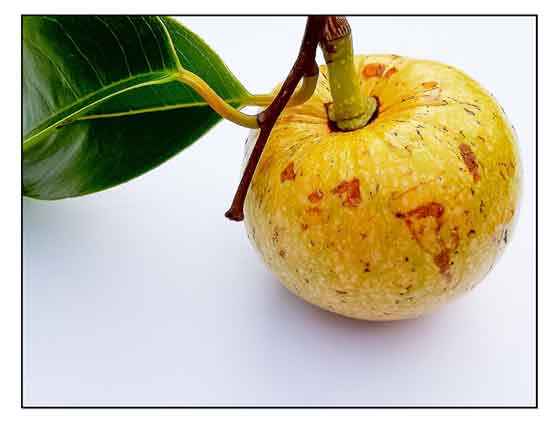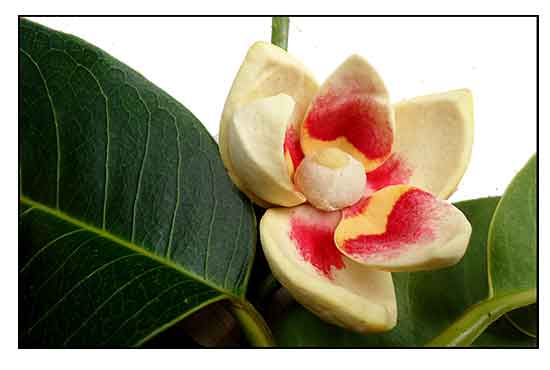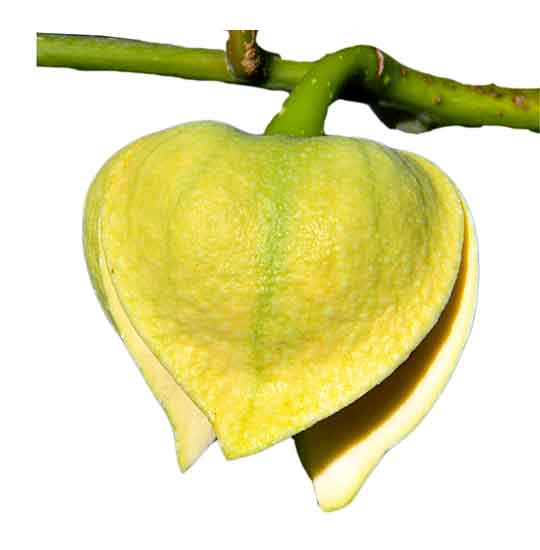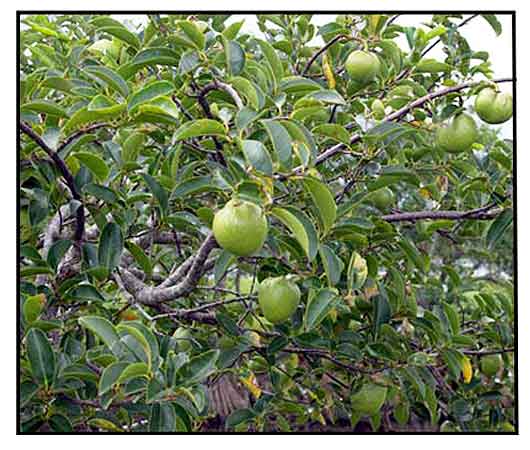 Gen info Gen info
- Annona is a genus of flowering plants in the pawpaw/sugar apple family, Annonaceae. It is the second largest genus in the family after Guatteria, containing about 166 species.
-
Annona glabra is a tropical fruit tree in the family Annonaceae, in the same genus as the soursop and cherimoya.
-
In Australia, considered a troublesome invasive species, classified as a WON (Weed of National Significance). It is was considered the highest ranked species in 2003 in a Wet Tropics
bioregion weed risk assessment.
- Etymology: The genus name Annona is a Latinized form of the vernacular name anon, a Hispaniolan Taino word for the fruit, given by the Taino Indians of America. Species epithet glabra means smooth, bald, or hairless.
- Ecology: Annona glabra thrives in wet environments. During wet seasons, seeds and fruits can fall into swamps and rivers to eventually spread to coastlines. A study showed that seeds can withstand floating in salt water and fresh water for 12 months, about 38% of seeds germinating in soil. Compared to other species of Annona
seeds and trees, A. glabra is more resilient to flooding. (34)
 Botany Botany
Annona glabra is a tree to 12 m tall, evergreen. Branches glabrous, lenticellate. Axillary leaf buds ovoid, fulvous pubescent, apex obtuse. Petiole 0.8-2.5 cm; leaf blade ovate, elliptic-ovate, elliptic, or oblong, 6-20 × 3-8 cm, papery to thinly leathery, glabrous at maturity, secondary veins 7-12 on each side of midvein and forming a ca. 60° angle with midvein, secondary and reticulate veins prominent on both surfaces when dry, base obtuse to rounded and slightly decurrent onto petiole, apex acute to obtuse. Inflorescences internodal or terminal on a short branchlet, 1-flowered. Flower buds ovoid to subglobose. Pedicel 1.5-2 cm, glabrous. Sepals broadly ovate, 3-4 × 3-4 mm, free, glabrous. Outer petals greenish yellow to pale yellow and inside basally with a red spot, broadly ovate, 1.5-3 × 1.3-2.5 cm, outside glabrous, inside minutely puberulent, apex obtuse; inner petals outside yellow, inside carmine, 1.2-2.5 × 0.7-1.5 cm, minutely puberulent. Stamens oblong, 3-4 mm; connectives apically slightly convex. Carpels connate at anthesis, glabrous. Syncarp yellow to orange, ovoid, 5-12 × 5-8 cm, smooth, apex rounded. Seeds pale reddish brown, 1.3-1.5 cm. (Flora of China)
 Annona glabra trees grow to up to 12 m. They have narrow, gray trunks and sometimes grow in clumps. Leaves are ovate to oblong, each with an acute tip, 8–15 cm long and 4–6 cm broad with a prominent midrib. The upper surface is light to dark green. Leaves of the A. glabra are said to have a distinct smell, similar to green apples, that can distinguish it from mangroves. Fruit is oblong through spherical and apple-sized or larger, 7–15 cm long and up to 9 cm diameter, and falls when it is green or ripening yellowish. It disperses by floating to new locations, and it is food for many animal species such as wild boar. Reproduction begins around two years of age. A fruit contains 100 or more convex, light yellow-brown seeds, about 1 cm long. A. glabra flowers have a short life-span, and have a diameter of 2–3 cm. The flowers have three outer petals as well as three inner petals. Compared to the pale yellow or cream color of the petals, the inner base of the A. glabra flower is a bright red. Pollen is shed as permanent tetrads. (34) Annona glabra trees grow to up to 12 m. They have narrow, gray trunks and sometimes grow in clumps. Leaves are ovate to oblong, each with an acute tip, 8–15 cm long and 4–6 cm broad with a prominent midrib. The upper surface is light to dark green. Leaves of the A. glabra are said to have a distinct smell, similar to green apples, that can distinguish it from mangroves. Fruit is oblong through spherical and apple-sized or larger, 7–15 cm long and up to 9 cm diameter, and falls when it is green or ripening yellowish. It disperses by floating to new locations, and it is food for many animal species such as wild boar. Reproduction begins around two years of age. A fruit contains 100 or more convex, light yellow-brown seeds, about 1 cm long. A. glabra flowers have a short life-span, and have a diameter of 2–3 cm. The flowers have three outer petals as well as three inner petals. Compared to the pale yellow or cream color of the petals, the inner base of the A. glabra flower is a bright red. Pollen is shed as permanent tetrads. (34)
Distribution
- Introduced.
- Cultivated; not naturalized.
- In Australia and Sri Lanka, considered a troublesome invasive species.
- Native range of the species is Tripical and Subtropical America, W. & W. Central Tropical Africa. (1)
 Constituents Constituents
- GC-MS study of hexane extract identified three major compounds: tritriacontane (30.23%), 13,17-dimethyl-tritriacontane (22.44%), and limonene (18.97%). (see study below) (5)
- Study of methanol extract of fruits isolated one new, (2E,4E,1'R,3'S,5'R,6'S)-dihydrophaseic acid 1,3'-di-O-β-d-glucopyranoside (1), and eight known compounds, (2E,4E,1'R,3'S,5'R,6'S)-dihydrophaseic acid 3'-O-β-d-glucopyranoside (2), icariside D2 (3), icariside D2 6'-O-β-d-xylopyranoside (4), 3,4-dimethoxyphenyl O-β-d-glucopyranoside (5), 3,4-dihydroxybenzoic acid (6), blumenol A (7), cucumegastigmane I (8), and icariside B1 (9). (see study below) (6)
- Study of alcoholic leaf extract yielded flavonoids, terpenoids, glycosides, steroids, saponins, tannins, anthraquinones, and acidic compounds. (see study below) (8)
- Study of hexane extract of stem bark
isolated kaur-16-en-19-oic acid as main constituent. (7)
- Steam distillation and GC and GC-MS analysis for volatile constituents yielded main compounds of
ß-caryophyllene (21.5%), germacrene (17.7%),
α-cadinol (5.4%) and ß-elemene (5.2%). (12)
- Study reports on the reversed-phase HPLC isolation of ent-kaur-16-en-19-oic acid (1) from the leaves and bark of Annona glabra. The compound was found to accumulate in the bark with only low concentrations in the leaves. (15)
- Bioactivity-directed fractionation of ethanolic extract of leaves of A. glabra isolated blumenol A (1), isolated for the first time from the Annonaceae family.
(see study below) (16)
- HPLC microfractionation with bioassay yielded 20 compounds, four of which, (7S,14S)-(-)-N-methyl-10-O-demethylxylopinine sale (3), S-(-)-7,8-didehydro-10-O-demethylxylopininium salt (10), S-(-)-7,8-didehydrocorydalminium salt (11), and 5-O-methylmarcanine D (17), were assigned as new natural products. (see study below) (19)
- Study of fruits isolated three new ent-kaurane diterpenoids, 7β,16α,17-trihydroxy-ent-kauran-19-oic acid (1), 7β,17-dihydroxy-16α-ent-kauran-19-oic acid 19-O-β-d-glucopyranoside ester (2), 7β,17-dihydroxy-ent-kaur-15-en-19-oic acid 19-O-β-d-glucopyranoside ester (3) along with five known compounds. (see study below) (20)
- Study of seed isolated four acetogenin compounds:
expoxyrolin B (1), neo-desacetyluvaricin (2), annonareticin (3), and murisolin (4), which were isolated for the first time from seeds. (22)
- Activity-directed fractionation of leaves using brine shrimp lethality test isolated two new bioactive bis-THF Annonaceous acetogenins, glabracins A (1) and B (2), and two previously known acetogenins, javoricin (3) and bullatanocin (4). (see study below) (23)
- Fractionation of ethanol extract of leaves of Annona glabra isolated two new bioactive Annonaceous acetogenins, annoglaxin (1) and 27-hydroxybullatacin (2). (see study below) (24)
- Study of 95% EtOH extract of bark of Annona glabra isolated a new kaurane diterpenoid, named
16α-hydroxy-17-acetoxy-ent-kauran-19-oic acid. (25)
- Bioassay guided fractionation and separation of EtOH extract of A. glabra leaf against acetycholinesterase led to the characterization of 15 alkaloids. Among them, (–)-actinodaphnine (2) and (–)-(6aS,7R)-7-hydroxyactinodaphnine (9) are new aporphines, although (+)-2 and (±)-2 have been found in several plants. (see study below) (30)
- Bioactivity-directed fractionation of ethanolic extract of leaves of A. glabra isolated two new bioactive adjacent bis-THF Annonaceous acetogenins, 6-OH desacetyluvaricin (1) and 6-OH 4-deoxysquamotacin (2). (see study below) (31)
- Study of Annona glabra fruits isolated a new ent-kaurane glycoside, annoglabasin H (1) and three known ent-kauranes, annoglabasin E (2), annoglabasin B (3), and 19-nor-ent-kaurent-4-ol-17-oic acid (4). (see study below) (32)
Properties
Studies have suggested anticancer, antioxidant, antimicrobial, larvicidal, acetylcholinesterase inhibitory, anti-inflammatory, anti-Leishmania, anti-termites, burn wound healing properties.
Parts used
Fruits, leaves, bark, seeds.
Uses
Edibility
-Fruit is edible. Unlike other Annona species, the pulp of ripe fruit is yellow through orange instead of whitish. Taste is similar to ripe honeydew melon. In Maldives, it is a popular ingredient of fresh fruit drinks. (2)
- Fruits made into jam, fruit drinks, and wine. (see study below) (26) (28) (33)
- Leaves used for making tea.
Folkloric
- No reported folkloric medicinal use in the Philippines.
-
In the past, crushed seeds cooked in coconut oil used to rid the hair of lice.
- In Guayana, decoction of leaves used for treating flatworms and nematodes. Seeds are crush and boiled, used externally to treat head lice.
- Infusion of bark and leaves, combined with bark and leaves of Annona squamosa, used as sedative and cardiotonic.
- In China, used for treatment of chronic bronchitis and cancer.
Others
- Insecticide: Leaves and seeds used as insecticide. Leaves in hen's nests kills lice on hens.
- Fish poison: Seeds used as fish poison.
- Fiber: Bark yields a fiber.
- Wood: Wood is light, soft, easily sawn, moderately resistant to rot. Used for making bottle stoppers and oars; used as substitute for cork in fishing nets.
(35)
Studies
• Anticancer / Human Leukemia Cell Lines: Study evaluated the anticancer effects of alcoholic extracts prepared from leaves, pulp, and seed against human leukemia cell lines. The extracts were not cytotoxic to normal human lymphocytes. However, extracts were highly cytotoxic to drug sensitive (CEM) and multidrug-resistant leukemia (CEM/VLB) cell lines. The seed extract was more potent than leaf and pulp extracts, and cytotoxicity values were significantly lower than adriamycin. The seed extract showed concentration-dependent increase in percentage of sub G0/G1 cell population Treatment of CEM and CEM/VLB cells with extract induced apoptosis and necrosis in sensitive and resistant leukemia cells in a concentration-dependent manner. The extract enhanced cellular daunorubiicin accumulation and up-regulated the expression of cyclin kinase inhibitor contributing to arrest of cells at G0/G1 phase. Results suggest a potential source of anticancer compounds. (3)
• Anticancer Diterpenoid Compounds: Study evaluated the inhibitory effect of two diterpenoid compounds (cunabic acid and ent-kauran-19-al-17-oic acid) isolated from A. glabra. The two compounds inhibited the proliferation of human liver cancer (HLC) cell line SMMC-7721. The mechanism is correlated with the induction of apoptosis by down-regulating the gene expression of bcl-2 gene and upregulating bax gene. (4)
• Anticancer / Antiviral Diterpenoid Compounds: MTT assay evaluated the cytotoxicity of hexane extract of A. glabra on six human cancer cell lines: liver (HepG2), pancrease (PANC-1), lung (A-549), breast (MCF-7, HTB-22), prostate (PC-3), and colon (CACO-2, ATB-37). The extract showed cytotoxicity against both CACO-2 and A-549 cancer cell lines with IC50s of 47 and 56.82 µg/ml, respectively, compared to doxorubicin IC50s of 31.91 and23.39. It exhibited moderate-to-weak activities against the other cell lines. The extract also showed promising protective and virucidal activity against HSV1 with no significant difference with acyclovir, and showed mild protective antiviral activity against HSV. Results suggest potential for antiviral and anticancer substances for pharmaceutical use. (see constituents above) (5)
• Anticancer / Cytotoxicity Activity on HL-60 Cell Line / Fruits: Study of methanol extract of fruits isolated one new, (2E,4E,1'R,3'S,5'R,6'S)-dihydrophaseic acid 1,3'-di-O-β-d-glucopyranoside (1), and eight known compounds. Icariside D2 (3) showed significant cytotoxic activity on HL-60 cell line with IC50 of 9.0 µM with no cytotoxicity on Hel-299 normal cell line. The compound induced apoptosis via alteration of expression of apoptosis-related proteins and decreased phosphorylation of AKT in HL-60 cells. (see constituents above) (6)
• Anticancer / Antiproliferative / Human Leukemia Cells / Leaves: Study evaluated the in vitro mitochondria-mediated anticancer and antiproliferative effects of Annona glabra leaves on MC-10910 human monocytic leukemia cells based on phytochemical analysis, cell viability, free radical scavenging, intracellular ROS levels, ATP content, mitochondrial fragmentation, and cell migration assays. Leukemia cell viability was reduced up to 28% after incubation, while free radical reducing power and scavenging activities were significantly increase. There was significant inhibition of leukemia cell colony formation, increased ROS, decreased ATP, and condensed, fragmented, and clumped mitochondria were observed in treated cells. Treated leukemia cells exhibited reduced migratory potential. Results suggest potential anticancer agent against human leukemia cells. (8)
• Neuroprotective / Ethanol-Induced Apoptotic Neurodegeneration: Study evaluated the neuroprotective effect of A. glabra extract (AGE) against ethanol-induced neurodegeneration in neonatal rats. Ethanol-AGE supplementation reduced degenerative alterations and hippocampal damage. Reduced cultured hippocampal neuron cell viability and increased apoptosis noted in control rats were significantly recovered following ethanol AGE-supplementation. Results suggest AGE-supplementation was very effective against neurodegeneration in neonatal rats. (9)
• Antioxidant / Fruit Cream Formulation: Study evaluated crude extract of A. glabra fruit for free radical scavenging activity. A 75% concentration of the methanolic fruit extract showed highest antioxidant activity. A cream formulation was retested using DPPH and Hydrogen Peroxide assay for free radical scavenging potential which showed dose- and concentration-dependent antioxidant activity. Antioxidant activity was attributed to the presence of flavonoids and tannin. (10)
• Silver Nanoparticles / Mosquito Larvicidal / Leaves: Study reported on the mosquito larvicidal potential of green synthesized silver nanoparticles using Annona glabra leaves. The AgNPs were tested against 3rd instar larvae of dengue vector mosquitoes, Aedes aegypti and Ae. albopictus. The AgNPs exhibited very high larvicidal activity against dengue mosquito larvae. Ae. albopictus was more susceptible than Ae. aegypti to a given
concentration of AgNPs and to crude aqueous leaf extract of A. glabra. The larvicidal effect of the An-AgNPs was superior to the crude aqueous leaf extract. Results suggest the AgNPs is a potent larvicide for dengue vector control. (11)
• Antimicrobial / Leaves: Study evaluated extracts of powdered plant materials for antimicrobial activity using disc diffusion method. Results showed effect antimicrobial activity against Bacillus cereus, Pseudomonas aeruginosa, and Shigella felxneri, comparing favorably with standard antibiotics Penicillin and Ampicillin. (13)
• Acetogenin / Leaves: Annonaceous acetogenins have aroused considerable interest as a possible source of antitumor drugs. Acetogenin fractions were identified in the leaves using Kedde's reagent and isolated by column chromatography. The preliminary study provides a platform for further pharmacological and therapeutic studies. (14)
• Blumenol A / Cytotoxicity / Leaves: Bioactivity-directed fractionation of ethanolic extract of leaves of A. glabra isolated blumenol A (1), isolated for the first time from the Annonaceae family. It showed general cytotoxic effect against human solid tumor, although not significantly potent. (16)
• Antimicrobial / Fruits: Study evaluated various solvent extracts of A. glabra fruits for antimicrobial activity using disc agar plate diffusion tests. All tested extracts viz. methanol, n-butanol, and ethyl acetate showed remarkable antimicrobial activities. The EA extract showed antimicrobial inhibition zone values ranging from 10-16 mm. The ME showed inhibition zones from 8-21mm against S. aureus, E. coli, C. albicans, and A. niger. GC-MS analysis showed that 3,5-decadiyne, 2,2-dimethyl- (24.93%), hexadecanoic acid, methyl ester (12.92%), and hexadecanoic acid, methyl ester (23.69%) were main chemical ingredients in the ethyl acetate, n-butanol, and methanol extracts, respectively. Results suggest A. glabra fruits could be a good source of natural antimicrobial agents. (17)
• Anti-Inflammatory in Cancer / Antioxidant / Prostate Cancer Cell Line: Study evaluated the anti-inflammatory function of Annona glabra extract by secretory phospholipase As (sPLA2) inhibition and MTT assay on prostate cancer (PC3) cell line. An acetone extract inhibited sPLA2IIA and showed highest free radical scavenging activity in DPPH (IC50 85.68 µg/mL) and phosphomolybdenum assay. MTT assay on prostate cancer (PC3) cell line showed moderate cell growth inhibition at higher test concentrations (800 µg/ml). (18)
• Acetylcholinesterase Inhibitory: HPLC microfractionation with bioassay yielded 20 compounds, four of which, (7S,14S)-(-)-N-methyl-10-O-demethylxylopinine sale (3), S-(-)-7,8-didehydro-10-O-demethylxylopininium salt (10), S-(-)-7,8-didehydrocorydalminium salt (11), and 5-O-methylmarcanine D (17), were assigned as new natural products. Compound 3, pseudocolumbamine (12), palmatine (15), and pseudopalmitine (16) showed anti-AChE activity, with IC50s of 8.4, 5.0, 0.4, and 1.8 µM, respectively. (19)
• Anti-Inflammatory / Nitric Oxide Inhibitory Activity / Fruits: Study of fruits isolated three new ent-kaurane diterpenoids, 7β,16α,17-trihydroxy-ent-kauran-19-oic acid (1), 7β,17-dihydroxy-16α-ent-kauran-19-oic acid 19-O-β-d-glucopyranoside ester (2), 7β,17-dihydroxy-ent-kaur-15-en-19-oic acid 19-O-β-d-glucopyranoside ester (3) along with five known compounds, paniculoside IV (4), 16α,17-dihydroxy-ent-kaurane (5), 16β,17-dihydroxy-ent-kaurane (6), 16β,17-dihydroxy-ent-kauran-19-al (7), and 16β,17-dihydroxy-ent-kauran-19-oic acid (8). All compounds were evaluated for inhibitory activity against nitric oxide (NO) production in LPS-stimulated RAW 264.7 macrophages. Compound 3 showed potent inhibitory of LPS-stimulated NO production in RAW 264.7 macrophages with IC50 0.01 µM. Compounds 1 and 7 showed significant inhibitory NO production with IC50s of 0.39 and 0.32 µM, respectively. (20)
• Anti-Leishmania Mechanisms / Review: Leishmaniasis is a neglected tropical disease caused by protozoan parasites of the genus Leishmania and characterized by formation of ulcers. The review discusses the main anti-Leishmania mechanisms of Annona glabra. Different Annona species have demonstrated antileishmanial activity in vitro. For Annona glabra, antileishmanial activity is attributed to alkaloids. (21)
• Glabracins / Cytotoxic to Human Tumor Cell Lines / Leaves: Activity-directed fractionation of leaves using brine shrimp lethality test isolated two new bioactive bis-THF Annonaceous acetogenins, glabracins A (1) and B (2), and two previously known acetogenins, javoricin (3) and bullatanocin (4). Compounds 1 and 2 showed selective cytotoxicity to certain human tumor cell lines, with compound 1 showing more significant potency. (23)
• Glabracins / Cytotoxic to Human Tumor Cell Lines / Leaves: Fractionation of ethanol extract of leaves of Annona glabra isolated two new bioactive Annonaceous acetogenins, annoglaxin (1) and 27-hydroxybullatacin (2). Compound 2 showed interesting selectivity for human breast carcinoma (MCF-7) cell line. Compound 2 was at least 100,000 times more potent than adriamycin against human kidney carcinoma (A-498), prostate carcinoma (PC-3), and pancreatic carcinoma (PACA-2) cell lines. (24)
• Quality Parameters of Pond Apple Jam: Study evaluated the factors that affect the quality of pond apple jam. Results showed when added fruit flesh to juice/water was 40%, the product produced a high-value bright yellow, with the jam gaining highest score from sensory panel i.e., perceptive color (5.05), flavor (4.98), taste (5.22) and texture (5.12) A pH of 3.2 and sugar concentration of 55%, the product with 40% added fruit flesh showed highest sensory value in measures of color, odor, taste and texture. (26)
• Anti-Termite
/ Seeds: Study evaluated the efficacy of A. glabra n-hexane and ethyl acetate seed extract against wood degrading termites. Paper disc test showed the extract to be toxic to Cryptotermes cynocephalus (dry-wood termites) and Coptotermes curvignathus (subterranean termites). The higher extract concentration (up to 63%) resulted in higher termite mortality (up to 100%). The ethyl acetate extract of seeds exhibited better toxicity effect than n-hexane extract. (27)
• Quality Parameters of Pond Apple Fruit Drink: Study evaluated the utilization of pond apple fruits to develop Ready-To-Serve (RTS) drinks in measures of sensory, physicochemical and microbiological properties. The best consumer preferred formula was a drink with 10% fruit pulp, 15% sugar, 74.6% water, 0.2% citric acid, 0.1% pectin, and 0.1% sodium metabisulfite at 15oBrix. Study suggests the pond apple fruit drink has potential as a RTS drink. (28)
• Burn Wound Healing / Leaves: Study evaluated the healing activity of leaf extract loaded calcium alginate film on third-degree burn wounds induced in Swiss albino mice. Formulations contained 0, 1.0, 2.0, 3.0 and 4.0% (w/v) leaves extract. The group receiving formula containing 3% extract showed significant higher healing rate in comparison to controls. (29)
• Anti-Acetylcholinesterase Alkaloids / Leaves: Bioassay guided fractionation and separation of EtOH extract of A. glabra leaf against acetycholinesterase led to the characterization of 15 alkaloids. Among them, (–)-actinodaphnine (2) and (–)-(6aS,7R)-7-hydroxyactinodaphnine (9) are new aporphines, although (+)-2 and (±)-2 have been found in several plants. (-)-Anolobine (5) and (-)-roemeroline (8) showed moderate inhibitory activity against eel acetylcholinesterase with IC50 values of 22.4 and 26.3 μM, respectively. (30)
• Bis-THF Acetogenins / Antitumor / Leaves: Bioactivity-directed fractionation of ethanolic extract of leaves of A. glabra isolated two new bioactive adjacent bis-THF Annonaceous acetogenins, 6-OH desacetyluvaricin (1) and 6-OH 4-deoxysquamotacin (2). Compounds 1 and 2 showed potent and selective cytotoxicity to six human solid tumor cell lines. (31)
• ent-Kaurane Diterpenes / Cytotoxic Against Human Cancer Cell Lines / Fruits: Study of Annona glabra fruits isolated a new ent-kaurane glycoside, annoglabasin H (1) and three known ent-kauranes, annoglabasin E (2), annoglabasin B (3), and 19-nor-ent-kaurent-4-ol-17-oic acid (4). The compounds were tested against four human cancer cell lines, LU-1, MCF-7, SK-Mel2, and KB. Compound 1 exhibited significant cytotoxic activity on all tested human cancer cell lines with IC50s ranging from 3.7 to 4.6 µM. (32)
• Wine from Ripe Pond Apple Fruits: Study evaluated the possibility of wine production from ripe pond apple fruits. At the end of malolactic fermentation, wine was racked and clarified. Gelatin revealed to be the best clarifying agent to removed turbidity in the wine while retaining most phenolic content and antioxidant capacity. High ethanol content, phytochemical retention, pleasant flavor, and attractive appearance contributed to high sensory score for an acceptable alcoholic drink. (33)
• Antimicrobial Flavonoids / Binding to Cell Walls: Study evaluated the antimicrobial activity of ethyl acetate fraction (EAF) from hydroalcoholic leaf extract of A. glabra. EAF was bactericidal against different strains of Pseudomonas aeruginosa. EAF showed time- and concentration-dependent effect of P. aeruginosa viability. Subfraction 32-33 (SF32-33) showed high flavonoid content, which on incubation with P. aeruginosa ATCC 27983 triggered an endothermic reaction, suggesting high binding of SF32-33 compounds to bacterial cell walls. Results suggest A. glabra derived compounds, especially flavonoids, may be useful for treating P. aeruginosa infections. (36)
Availability
- Cultivated.
|

![]()






 Constituents
Constituents